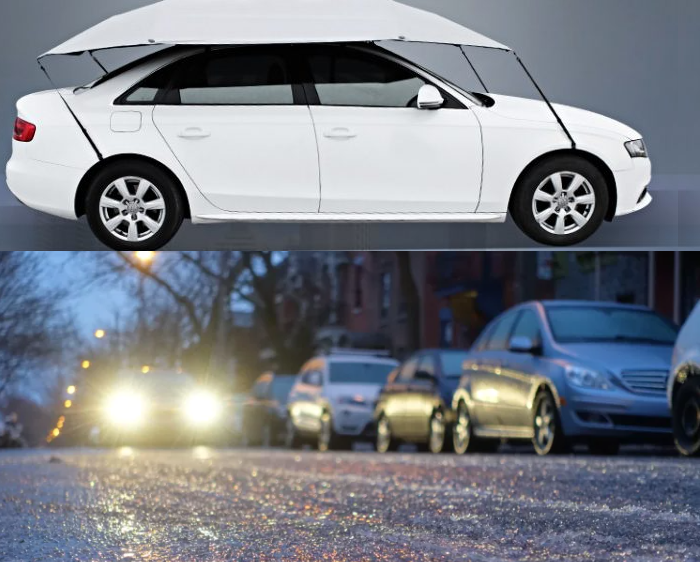Mistakes to Avoid and Tips to Follow When “Parking a Car in the Rain”
- On Dec, 16, 2022
- Admin
Here in Malaysia, most of us park our car on the streets (in front of our house or nearby or wherever it is possible and easy) because there are not enough covered parking spaces available, especially, in urban areas. However, it is not a good idea to leave your car in the rain because excess water can ruin the car's paint and damage the car's engine and headlights. Following are the disadvantages of leaving the car parked in the rain:

• Rain can damage car's engine
If car is left in rain, rainwater may enter the important parts of the car's engine. In addition, dirt and mud may accumulate in hard-to-reach areas. This may lead to rust and damage to the car's engine.
• Rain may damage the headlights
Car headlights are secured with watertight seals. Due to continued wear and tear, the seals may loosen, allowing rainwater to enter. These water droplets may affect visibility at night and change the direction of the light beam.
• Damage the vehicle from the outside
The exterior parts of the car are the most susceptible to damage due to rain. Dust and grime accumulated on the exterior of the car damage the car’s paint, and this is made worse by rain, especially acid rain.
Then there is a question that should the car be covered in rain?
No, you should never cover your car in rain as it can damage your car's paint. Car covers will protect your car from dust, mud and rainwater. However, after getting wet from rainwater, the cover may stick to the outside of the car, then, when you pull the cover; it may peel off your original car paint.
What you can do instead is, park your car indoors or under a shed, if there is no such parking solutions available then you can use a waterproof cover to protect your car from the rain.
Remember, the car cover cannot be left on the car during the rain unless the car cover is waterproof, water-resistant, and breathable. While in the case of normal car covers, it can stick to the surface of the car after getting wet in the rain, this may damage the final appearance of the car paint and damage the general appearance of your car, it will also cause the car's metal to rust. But make sure the car is dry before you put the cover on it.
How to protect cars in the rainy season?
The rainy season can take a heavy toll on your car if you do not take proper measures to protect it. Here are some tips to protect your car:
Rain can damage car's engine
1. Clean and wax your car, use ceramic polish or a paint protectant that does not allow water to settle on the surface of the car.
2. Start covering your car in the rain; it will be much better if you park your car under a shed or better yet in a basement.
3. Make sure to clean dust frequently, dirt and grime under the hood and trunk lid, as accumulated dust and dirt can clog the vehicle's internal drainage system.
4. Spraying a mixture of diesel and engine oil on the bottom of the car can help protect the car from rusting.
5. Use dry towels for seats and mats (which can absorb the rainwater) for the floor of the car to protect the interior parts of the car from moisture and mold formation.
6. Maintain the air-conditioned vehicle as you will be working full time during the rains.
7. Check your car's wipers blades to make sure they are not dry rotten or smearing, streaking rubber may cause scratches on the windshield due to improper wiping as well as squeaking. It is advised to use silicon made wipers because it is gentle to windshield and durable long lasting.
8. Check your tire's tread and make sure that wear and abrasion is not significant enough to prevent slipping while driving in the rain.
How to dry a wet car?
You can remove water from a wet car interior in many different ways using different tools. To dry a wet car, you will need dry cloth towels, fans, a hair dryer, and a moisture-absorbing product like baking soda. Here are some easy steps to dry a wet car off the road:
1. Remove as much water as possible and as quickly as possible.
2. Use a towel or sponge to absorb the remaining water, make sure to reach every nook and cranny of your seat such as armrests, space between seats, under the seats etc.
3. Blot the water off the floor mats and seats with a cloth. Do not use paper towels? As they do not absorb as much water as cloth towels or sponge absorbs.
4. Open the drain plugs under your car (if any) to remove trapped water.
5. Next, place two fans so that they blow on the floor and seats of your car from side to side. Keep the fans running for a minimum duration of 24 hours.
6. Even after all these steps, there is still some moisture left that could lead to mold formation, so grab a hair dryer and blow the areas that might still be damp.
7. Finally, you can apply moisture-absorbing products like baking soda to dry out the car's interiors over time.
Can rainwater damage your car’s engine?
Yes, rain can seriously damage a car's engine, because rainwater can get inside the engine and can cause permanent damage.
• This is especially the case when you try to restart your car while there is water trapped inside the engine case, fluids may mix with water and affect your car's performance.
• If you are stuck in a situation where your engine has been flooded, do not attempt to restart the vehicle, restarting your vehicle will make room for more water to enter the engine and cause a water lock.
• Remove the water as quickly as possible to prevent further damage to the vehicle's mechanical components and wiring.
• You can use towels to soak up the water, but make sure not to use a regular vacuum cleaner.
• Use a fan or natural sunlight to allow any remaining moisture to evaporate.
Will rain affect the new car paint?
Rain can cause serious damage to the paintwork of new cars as the pollutants present in rainwater can corrode the metal of the car. Mud particles present in rainwater can be accumulated on the roof of the car and under the car causing overall damage to the car. However, you can take some precautions to protect your car from the effects of rain. Your car will be in a good condition for a longer period, and that could mean more money for you at sale or trade-in time in the future.
1. Cover your car with wax so that the water runs off the surface of the car. This helps keep the new car paint intact and prevents the car from corroding at scuffs and scratches.
2. Park under the shed or indoors (if possible). Use window visors to prevent any water from entering the cabin. These also help prevent fogging.
3. Furthermore, use the bug deflector to keep any insects or projectiles away from hitting your windshield. You can also lubricate the parts of the car that are exposed to rain. Also, check the rubber seals on the windshield and windows to see if they are tight enough to stop the water from coming inside.
We have provided you, with some tips that must be followed when parking your car in the rain. Please stay tuned for coming article, “Tips for driving safely in a rainy season”.
If you want to know about importance of Hydroplaning in High Precipitation Regions, read follwoing article:
“Importance of Hydroplaning in High Precipitation Regions: Strategy for Malaysian Drivers”
About the Author
Dr. Hafiz Abbas holds a PhD in Usuluddin from Universiti Sultan Azlan Shah (USAS), Malaysia. He is well versed with Islamic theology, Seerat-un-Nabi (SAW), and principles of Hadith. In addition, he is a teacher of Arabic.
Edited by: Ch. Mahmood Anwar
Don't forget to leave a precious comment if you like this post.





















